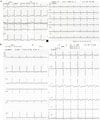Abstract
Some patients with idiopathic type 1 diabetes have a fulminant disorder characterized by the absence of insulitis and of diabetes-related antibodies, a remarkably abrupt onset and high serum pancreatic enzyme concentrations. This is referred to as fulminant type 1 diabetes. Cardiopulmonary disorders are rarely observed around the onset of fulminant type 1 diabetes. A 51-year-old woman suffering from nausea and vomiting was transferred to our hospital. Laboratory findings revealed high blood glucose level and the evidence of diabetic ketoacidosis, but the serum HbA1c was normal nevertheless. The low level of plasma C-peptide indicated the loss of endogenous insulin secretion. The patient satisfied the criteria for the diagnosis of fulminant type 1 diabetes. Electrocardiogram (ECG) revealed nonspecific ST-T-wave abnormalities. Transthoracic echocardiogram demonstrated that she had severe pulmonary hypertension and minimal pericardial effusion. In a week, pulmonary hypertension improved to mild degree without specific treatment. Acute myocarditis was suspected based upon flulike symptoms, nonspecific ST-T-wave abnormalities, minimal pericardial effusion and asymptomatic pulmonary hypertension. We considered it worthwhile reporting this case because fulminant type 1 diabetes with acute myocarditis has never been published yet.
Figures and Tables
Fig. 1
Electrocardiograms showing nonspecific ST-T-wave abnormalities. A, T-wave inversion in leads V1-V4 at presentation; B, ST-segment elevation in leads V2-V4 and T-wave inversion in leads II, III, aVF, V1-V6 on the following day.

References
1. Expert Committee. Report of the expert committee on the diagnosis and classification of diabetes mellitus. Diabetes Care. 2003. 26:Suppl 1. S5–S20.
2. Imagawa A, Hanafusa T, Miyagawa J, Matsuzawa Y. Osaka IDDM Study Group. A novel subtype of type 1 diabetes mellitus characterized by a rapid onset and an absence of diabetes-related antibodies. N Engl J Med. 2000. 342:301–307.
3. Imagawa A, Hanafusa T, Uchigata Y, Kanatsuka A, Kawasaki E, Kobayashi T, Shimada A, SHimuzu I, Toyoda T, Maruyama T, Makino H. Fulminant type 1 diabetes: a nationwide survey in Japan. Diabetes Care. 2003. 26:2345–2352.
4. Murase Y, Imagawa A, Hanafusa T, Iwahashi H, Uchigata Y, Kanatsuka A, Kawasaki E, Kobayashi T, Shimada A, Shimizu I, Maruyama T, Makino H. Fulminant type 1 diabetes as a high risk group for diabetic microangiopathy-a nationwide 5-year-study in Japan. Diabetologia. 2007. 50:531–537.
8. Sayama K, Imagawa A, Okita K, Uno S, Moriwaki M, Kozawa J, Iwahashi H, Yamagata K, Tamura S, Matsuzawa Y, Hanafusa T, Miyagawa J, Shimomura I. Pancreatic beta and alpha cells are both decreased in patients with fulminant type 1 diabetes: a morphometrical assessment. Diabetologia. 2005. 48:1560–1564.
9. Moriwaki M, Itoh N, Miyagawa J, Yamamoto K, Imagawa A, Yamagata K, Iwahashi H, Nakajima H, Namba M, Nagata S, Hanafusa T, Matsuzawa Y. Fas and Fas ligand expression in inflamed islets in pancreas sections of patients with recent-onset type I diabetes mellitus. Diabetologia. 1999. 42:1332–1340.
10. Imagawa A, Hanafusa T. Fulminant type 1 diabetes mellitus. Endocr J. 2006. 53:577–584.
11. Imagawa A, Hanafusa T, Makino H, Miyagawa JI, Juto P. High titres of IgA antibodies to enterovirus in fulminant type-1 diabetes. Diabetologia. 2005. 48:290–293.
12. Jun HS, Yoon JW. The role of viruses in type I diabetes: Two distinct cellular and molecular pathogenic mechanisms of virus-induced diabetes in animals. Diabetologia. 2001. 44:271–285.
13. Vreugdenhil GR, Schloot NC, Hoorens A, Rongen C, Pipeleers DG, Melchers WJ, Roep BO, Galama JM. Acute onset of type I diabetes mellitus after severe echovirus 9 infection: putative pathogenic pathways. Clin Infect Dis. 2000. 31:1025–1031.
14. Jung TS, Chung SI, Kim MA, Kim SJ, Park MH, Kim DR, Kang MY, Hahm JR. A Korean patient with fulminant autoantibody-negative type 1 diabetes. Diabetes Care. 2004. 27:3023–3024.
15. Jung JH, Hahm JR, Kim MA, Park MH, Kim DR, Jung TS, Chung SI. Fulminant autoantibody-negative and type 1A diabetes phenotypes in a Korean HLA identical dizygotic twin. Diabetes Care. 2005. 28:2330–2331.
16. Uto Y, Uto K, Teno S, Isono K, Omori Y. A case of fulminant type 1 diabetes mellitus detected after cardiac arrest due to diabetic ketoacidosis. J Japan Diab Soc. 2002. 45:689–693.
17. Kobayashi T, Isomine S, Goto M, Sato M, Kanazawa T, Sakaida K, Iwaoka H. A case of fulminant type 1 diabetes with ECG changes in the first trimester of pregnancy. J Jpn Soc Intensive Care Med. 2005. 12:25–30. (In Japanese).
18. Feldman AM, McNamara D. Myocarditis. N Engl J Med. 2000. 343:1388–1398. (In Japanese).




 PDF
PDF ePub
ePub Citation
Citation Print
Print




 XML Download
XML Download